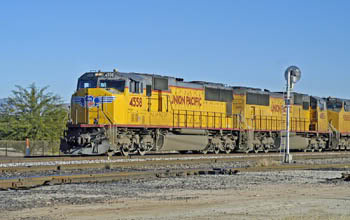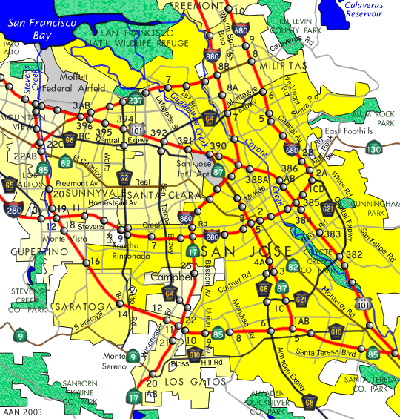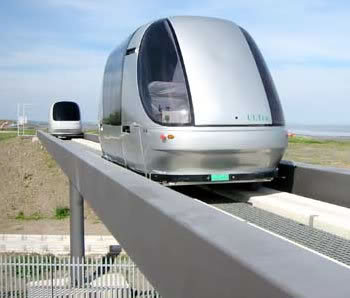This is the fourth in a series on how we can build an energy future based on our best science and no longer critically dependent upon exhaustible and polluting fossil fuels.
The tripartite approach allows our society to cut oil demand and dependence substantially within a decade, much more quickly than a sole reliance on electrification of the autonomous vehicle fleet through sales of battery-electric and plug in hybrid vehicles. Combining these vehicles with the already well-proven and easily scalable technology of vehicles that use trolley poles or a pantograph to draw power from the grid while in motion allows policy makers to take a leadership role when required to supplement the emerging market for personal or corporately owned electric vehicles. Most world leaders with a future orientation recognize a global energy crisis of enormous proportions where electric transport has a crucial role. In an under-publicized speech, British Prime Minister Gordon Brown already sees in electrification of transportation both a business opportunity for the U.K. and a more general solution to living in a post-oil world.

Advances in battery and ultracapacitor technology and manufacturing technologies are inevitable, but the timing of their widespread adoption will substantially lag demand for them. Insistent demands by concerned consumers that Tesla Motors or another manufacturer create in the next few years a battery electric vehicle that is priced at the level of gasoline powered economy cars are as of today wishful thinking.
Batteries, however, will remain far more advanced and widely available than hydrogen and hydrogen fuel cells. Though hydrogen may have a future role, the focus on hydrogen by policymakers and automakers has functioned as a distraction from electric technology, the clear next generation in powering transport. Unfortunately commercial interests that a decade ago wanted to delay the emergence of electric transport, held onto hydrogen as the next thing to, seemingly, prolong the era of profitable petroleum powered vehicles.
The tripartite strategy allows policy makers to respond more immediately to the demand for oil alternatives by implementing programs that build out grid-powered transportation infrastructure for freight and passenger traffic using “off the shelf” technologies. Policymakers can create incentive packages, issue bonds or levy taxes for the necessary work to keep America moving. Incentives for private companies to invest in electric transport infrastructure can be designed. Beyond its easy scalability, requiring few to no technical advances, powering vehicles directly from the grid is highly efficient because power is used directly after generation rather than diminished a fraction through charging and discharging a battery. Using that extra fraction of power for the convenience of storage is well worth it in many contexts but is not necessary for all transport tasks.
Building electrified rights of way

There are now a number of plans emerging on a national, continental, and local level to electrify transportation in part. Alan Drake, a contributor to a number of energy and transport websites, has devised a plan to electrify 36,000 miles of vital freight railways in the U.S. and increase the speed of rail freight; higher speed freight allows an easier commingling of freight and passenger traffic on the rails. A high speed (electric) passenger rail line is now being proposed in California to link San Diego and Los Angeles with San Francisco and Sacramento. Public transit advocates have created visions of how various cities could be transformed with expanded subway or light rail networks, many of which unfortunately require larger per mile investments than simply electrifying existing rails and roadways.
Building of new heavy and lighter rail infrastructure is inevitable but a rapid start to electrification will work with existing rights of way, tracks and roadways. As an exercise, imagine your own local area or, as the America 2050 plan [PDF] calls it your larger “megaregion” and visualize where are the highest traffic areas where we could rapidly transfer people and freight from petroleum dependent to electric transport.
An example: moving the Northern California megaregion off of oil

The Northern California megaregion, in which I live, extends over a huge square of land centered on one side on San Francisco, San Jose, and Oakland, approximately 250 miles per side extending into northern Nevada. The size of this region and the sprawl within it has been enabled by cheap petroleum transport energy despite its foundations in the pre-oil era. On the other hand, Northern California is better prepared than many areas of the Western and Midwestern U.S. to transition to an electricity-based transport system because of existing investments in concentrated freight and passenger transport and some denser core and corridor areas of residence and business. The transition will be more challenging for the “Arizona Sun Corridor,” the “Piedmont Atlantic” and the “Florida” megaregions with their still greater sprawl and dispersion of economic activity.
An inventory of existing electric transport assets in the Northern California megaregion yields the following:
- the highly successful regional Bay Area Rapid Transit system, a 3rd-rail driven commuter rail system for which there have been several expansion plans, that are now again made more likely.
- Three light rail systems in the City of San Francisco, in the City of Sacramento and in the Santa Clara Valley around San Jose.
- A trolleybus system in the city of San Francisco
- The venerable San Francisco cable car
These electric transport assets are largely focused at the traditional center of the area San Francisco and are currently designed for passengers and their hand-carried freight. There are however multiple existing non-electrified rail assets in the region for passengers and freight running on freight companies rights of way. These include:
- the Caltrain commuter train on the Union Pacific right of way from San Francisco to San Jose and Gilroy
- the Capitol Corridor regional trains from Oakland to Sacramento
- the ACE train from San Jose to Stockton
- Amtrak service linking major centers in the megaregion as well as tying the megaregion to the Southern California and Cascadia megaregions to the north and south.
- Freight rail service on the many active railways on both major trunk and also spur lines throughout the region serving industrial and commercial customers.
Electrifying many of these existing routes would further insulate Northern California from dependence upon oil markets. In addtion, the region’s Metropolitan Transportation Commission’s rail plan, announced in 2007, recommends track expansion in addition to that needed by the statewide High Speed Rail proposal. In this plan are efforts to separate out where possible freight and passenger rail to allow each to proceed on its own most efficient schedule. Grade separating rail in densely populated areas is an additional expense that with higher traffic becomes an enormous boost in the quality of life and quality of rail service. While as of last year these recommendations may have seemed like pie in the sky to some, events in the oil markets have made such efforts an ever higher priority.

Less expensive per mile and more rapidly deployed are electrified roadway systems, now used with trolleybuses but capable of accommodating dual mode electric trucks outfitted with trolley poles or pantographs. Focusing on passenger traffic, the Northern California megaregion can supplement the railed systems of travel by building at least one electrified lane for trolleybus traffic on major thoroughfares, connecting with rail transport resources. A listing of these routes for the Northern California megaregion would extend perhaps to 50 major street routes of 10 to 30 miles in length and would supplement existing rail infrastructure. These trolleybus routes can either be operated as Bus Rapid Transit in a segregated lane or can commingle with other traffic, part of the flexible appeal of trolleybuses. In addition trolleybuses can operate in residential neighborhoods in the evening and at night without disturbing residents. Almost any bus route could be electrified, though it makes sense to start with the highest traffic routes.
Once any strategy of electrification is recognized as the primary means of powering ground transport, blue ribbon panels of technical, financial, and transport analysts can be convened to determine what mix of rail and roadway electrification systems might best serve to fulfill our current and anticipated future transport needs. One of the priorities of the next Administration ought to be a study of long-distance roadway electrification versus the building out of electrified railway networks inclusive of the expense of improvement of existing railbeds and building new sets of parallel tracks in high traffic areas. Another factor involved in these studies would be the anticipated rate of improvement in mobile energy storage technologies and their manufacture.

Another electrified alternative is Personal Rapid Transit or PRT. Still an emerging concept, PRT may use either electrified rights of way or batteries in an automated system of electric “taxis” on guideways. A large PRT system would be unthinkable without advanced information technology and highly reliable automated controls. PRT advocates claim an overall lower environmental impact for their technology over traditional mass transit. PRT critics believe that no PRT system will be able to handle rush hour traffic volumes. The first true PRT system is being built for use at London’s Heathrow airport.
The grouping of shared and rent-able forms of transport around the main transport arteries and stations will further increase the utility and efficiency of the transport system. In France, there are free shared bicycle services clustered around transport hubs (Velib) and there are also proposals to introduce a shared electric car service with similar depots scattered around French cities. Van pool and ride-sharing services can grow based on determining where are the centers of transport demand and need.
Electrification of high traffic rights of way is one of the top priorities for both national security and energy security. Alan Drake, in focusing on the already-profitable freight business and rights of way, proposes that minimal federal incentives can stimulate large private investment in electrifying tracks owned by the large railway companies. Publicly owned rails or roadways would require debt financing or budgeting for construction directly from tax revenues for local, state or federal governments.


